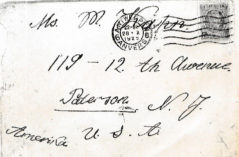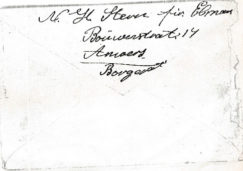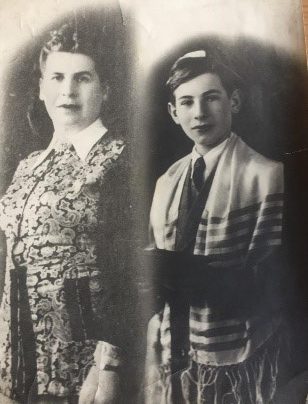by Hildagarde Sanders
Before the Envelope
When I was growing up, I learned a great deal of information about my mother’s family. However, I knew almost nothing about my father Nathan Kahn’s family, except that he and five of his six siblings were born in Łódź, Poland, where they had a silk mill. His father Max (a.k.a Mendel) came to the U.S. first, soon followed by his mother and siblings. I also knew that my father’s mother’s maiden name was Leib, and that she was called Minnie, with Sarah also part of her name.
My family frequently visited with my father’s siblings and their families who lived in Paterson, New Jersey. During some of these visits, my uncles mentioned the family’s original name in Poland. However, none knew exactly what it was, just something that it sounded like. Much later, in the 1980s, one of my uncles told me that, in Poland, before they left for the U.S., with a lawyer’s consultation, they had changed the name to Kahn because they were Kohanim.
Mendel, my grandfather, arrived in New York in 1913; Minnie Sarah and their five eldest children arrived in 1914, as I discovered from ship manifests. Using the emerging availability of the Internet to do genealogical research, I would sometimes ask relatives about the person for whom they were named. This question turned out to be a key to most of the information I subsequently learned about my paternal family.
About twenty years ago, my paternal cousin Nancy Soiferman, unfortunately no longer alive, told me that she was named for Neche, the sister of our grandmother Minnie Sarah Leib Kahn. Neche was murdered in a pogrom in Poland in 1932, she told me. Much later, accessing the JewishGen Online Worldwide Burial Registry (JOWBR), I found confirming information of her death, but no mention of a pogrom, from a Piotrkow burial record dated 15 December 1932.
By this time, I was familiar with Jewish Records Indexing-Poland (JRI-Poland). There, I found a treasure chest of information. A search for Neche and for Mindla Sarah Leib, together with my grandfather’s given name, Menachem Mendel, quickly brought up marriage records for both my grandmother and her sister. These records included not only the surname of my grandfather, Przatowsky, but also the name Elman, the surname of the husband of my grandmother’s sister Neche. The records revealed that the parents of these sisters were Hana Leah Kuperman and Berko Leib, and that my grandfather Mendel’s parents were Chaia Suri Kluch and Chiel Meyer Przetowsky[2]. Now I had more names to search on JRI-Poland and elsewhere.
The Envelope

During a visit to my paternal cousin Steven, in northern New Jersey, about 30 years ago, he showed me three envelopes that he had saved from his late father’s possessions. They had been sent by a person named Elman to my grandparents and great-uncle, who lived in Paterson, New Jersey. Two of the envelopes made sense to us because they were postmarked in Łódź, Poland, where our family had lived. However, one was postmarked in Antwerp, Belgium, was dated 1929, and had a return address for “N.H. Stern for Elman”. The envelope with the Antwerp postmark remained a great mystery to us over the next three decades. Why was my grandmother’s in-law mailing a letter from Antwerp? No one had ever mentioned that our family members lived anywhere other than in Łódź or in Paterson, New Jersey.

A Contact via JewishGen FamilyFinder
Thanks to the JewishGen FamilyFinder database, the answer was finally revealed. I had long ago entered family information on the Family Finder with the hope that someone knowing my family would respond. Among the information that I posted there was the name Elman, together with the city of Antwerp. No one responded to this posting for many years.
Then, in December 2019, I received an email from Reinier Heinsman[1], a young university student in Groningen, Netherlands, who volunteered to do some research for me. I learned that he has considerable experience doing genealogical research of his own family as well as for others. He was already familiar with the archives in Antwerp, where large amounts of information are kept for each resident, including documents filed when a resident moves from one district of the city to another or moves out of or into Antwerp. Of course, I agreed that he could search the Antwerp records for Elman.
Reinier first found a record of a young woman, Ides Mirla Elman, born in Łódź, Poland, living in the home of an Aron Kuperman. This was an important clue because of this connection of the Antwerp Elmans to a Kuperman, the maiden surname of the mother of my grandmother Mindla Sarah and her sister Frajda Neche. These records also mentioned a “Szifra Mindla Elman”, born in Łódź. I had already found Łódź Ghetto records for Szifra Mindla Elman, her two sisters, and their father. Several pieces of information now fit together.
However, there was a new question: Who was Aron Kuperman? The Antwerp archives and FamilySearch.org provided much information about him, including his date of birth and his Łódź birthplace.
The next question was: Who was Ides Mirla Elman? Reinier continued to send copies of numerous documents from the Antwerp archives to me about her. She was born in Łódź to Freyde Neche Leib and Abram Mordka Elman, the sister and brother-in-law of my grandmother. Ides Mirla married Naftali Stern. They had three children: Anny, Irma Irene, and Bernard. The family lived in Antwerp until May 1940, except for a short period in Łódź around 1930. That explained why the letter was mailed from Antwerp by Naftali Stern for his wife, Ides Mirla Elman.
From documents containing the details of her family’s situation that Ides Mirla later submitted to the Antwerp archives, I now knew where the family lived during World War II — from their departure until their return to Belgium. In addition, Bernard Stern has written a Petite Histoire de la Famille Stern, which he kindly shared with me. It contains even more details about his family’s life during the war from the perspective of a young boy. According to Bernard, in May 1940 the family, realizing the need to flee Belgium as arrival of the Nazis was imminent, planned to take a train to Ostend, Belgium, and from there a boat to England. However, crowds at the train station prevented them from boarding that train, so instead, Ides Mirla, Naftali, and their three children boarded a train to Brussels and then headed to France. Their train was strafed by German fighter planes, destroying the locomotive, but it eventually reached France. The family went to Lyon, which was under the Vichy government. By the latter part of 1942, the Nazis were taking over the territory that the Vichy French government had held, and it was obvious that Jews would be rounded up and taken to concentration camps. Therefore, the Stern family decided to escape to Switzerland, helped by a secret Catholic organization that aided Jews over the mountainous border to Switzerland, where they remained until May 1945, when they returned to Belgium.
The U.S. Holocaust Memorial Museum maintains a database of Holocaust Survivors and Victims. The record for 8-year-old Bernard’s arrival in Switzerland is included there (https://www.ushmm.org/online/hsv/person_view.php?PersonId=5545331).
The Rest of the Elman Family
Long before I learned who the Elman relative in Antwerp was, I had found information from JRI-Poland about the family in Łódź. Two of Frajda Neche and Abram Mordka’s sons died in Poland before World War II. Three of their daughters and Abram Mordka were taken to the Łódź Ghetto, where he and his daughter Hena died. The other two daughters, Mindla Szifra and Sara, were transported to Chelmno, where they were killed. Now I had learned much about a branch of my family about whom I and my cousins had previously known nothing.
Finding Surviving Elman Family Members
Based on birth dates that Reinier had obtained from the Antwerp archives, Bernard and his daughter, named Ides after her grandmother, could still be alive. Although Reinier and I attempted to contact them by email and phone during 2020, we received no response. Finally, in June 2021, Bernard sent an email to Reinier, explaining that the email address he had for Reinier must have been incorrect. Reinier then sent my email address to Bernard, and since then, Bernard, his daughters Ides and Noemi, and also the daughters of his sisters have sent emails or spoken to me. Bernard lives in Antwerp, Ides in Brussels, and Noemi in London. One niece lives in California and the other in Florida.
More Loose Ends Tied Up
I wanted to learn more about the Aron Kuperman with whom Ides Mirla Elman first lived after she arrived in Antwerp from Łódź. Records about him from Bernard, the Antwerp Police Immigration files, and JRI-Poland and translations by the Family History Museum staff all identified him as the brother of my great-grandmother Hanna Leah Kuperman and as Ides Mirla’s great-uncle.
Further research in JRI-Poland, together with document translations by members of the Family History Museum, identified the parents of Aron and Hana Leah as Moses Fiszel Kuperman and Pidach Niche Biedakow. The parents of Moses were Johon (perhaps Chona) Kuperman and Mindla Madzenk. Mindla’s parents were Josek and Nuche.
It is interesting and significant, in tracking family members, how given names and their variations are repeated, in conformity with Jewish custom, in this branch of the family, continuing down to my parents’ and my own generations: Fiszel, Sarah, Mindla, Neche, Hanna Leah, Berka. This continuity is reassuring that this family is truly my own.
Finding this branch of my family, who survived World War II, has been very exciting. The Antwerp archives, JRI-Poland, JewishGen Family Finder, the Family History Museum, and, especially, Reinier Heinsman deserve all the credit.
January 2022
Baltimore, Maryland
__________________________________
Footnotes
A version of this article originally appeared in the Winter 2021-2022 issue of L’dor V’dor, a publication of the JGS of Maryland. Permission has been granted to re-publish here.
[1] Reinier Heinsman is the author of both From the Children’s Home to the Gas Chamber: And How Some Avoided Their Fate and the Success! Story From Cluj to the Rest of the World: The Fate of the Five Jakab Siblings.
[2] Copies of these Polish marriage records were translated from Old Russian by the author’s neighbor. Civil records in the region of Poland under Russian control were written in Russian from 1868 until 1918.
Research Notes and Hints
Hildagarde’s foundation for her research efforts came from family visits where she interrogated relatives to learn who they were named for. These ancestor names were critical to her efforts to discovering ancestors, including a previously unknown family branch.
The advent of the internet opened a door to a variety of record sources that greatly facilitated Hildagarde’s research. Among these databases were the JewishGen Online Worldwide Burial Registry (JOWBR) and Jewish Records Indexing – Poland (JRI-Poland).
A cousin that Hildagarde was visiting showed her an old envelope sent from an unknown person living in Belgium; the family hailed from Łódź, Poland. This envelope would ultimately lead to the discovery of a previously unknown family branch. By virtue of Hildagarde’s foresight in placing family names on JewishGen’s Family Finder, an unrelated researcher, seeing Hildagarde’s Family Finder entry for the unknown Belgium name, offered to search the Antwerp archive files for her; the researcher was experienced in using this database.
Even unrelated people can be a source of family information. Reinier Heinsman, the researcher who saw the Family Finder entry, searched the immigration database, Felixarchief Antwerpen, and the Archives de la Police des Etrangers. FamilySearch.org provided the Antwerp Police Immigration Index, 1840-1930 database that contained records of the mysterious family branch. These efforts led to the discovery of surviving family members.

